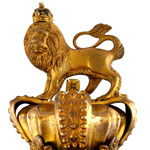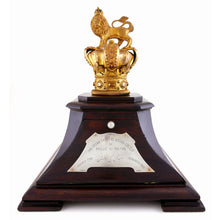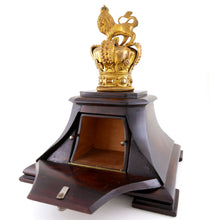Overall:14cm (5.5in)
Gilt metal & wood. In the form of the royal crest - the Imperial Crown, thereon a lion statant guardant, imperially crowned. The finial mounted on a dark wood concave ogee moulded base with champfered corners and a spring loaded compartment to the front applied with a silver plaque inscribed, ‘The Crown From The Queen’s Colour / of / Baillie-Ki-Paltan / Formed 1759 / Disbanded 1933’. Maker’s label of ‘Barton, Son & Co. / Silversmiths / Bangalore & Ootacumund’.
Baillie-Ki-Paltan was the ancient name of 2nd Battalion, Madras Pioneers. It was derived from the name of one of the earliest commanding officers of its ancestor unit, 5th Battalion of Coast Sepoys, raised in 1759. The officer in question was Colonel William Baillie, late H.M’s 89th Highlanders, who commanded the battalion for what was a relatively long period from 1765 to 1771. Baillie is noted for his gallant but ill-supported stand against Hyder Ali of Mysore and son Tipu Sultan at Pollilur in 1780 and subsequent imprisonment in Seringapatam ‘until death relieved his sufferings’.
Read more
Over the years the regiment was known by a number of different titles the 5th Carnatic Battalion 1769–1770, the 4th Carnatic Battalion 1770–1784, the 4th Madras Battalion 1784–1796, 1st Battalion, 4th Madras Native Infantry 1796–1824, the 4th Madras Native Infantry 1824–1883, the 4th Madras Native Infantry (Pioneers) 1883–1901, the 4th Madras Infantry (Pioneers) 1901–1903 and finally after the Kitchener reforms of the Indian Army when the names of the presidencies were dropped the 64th Pioneers. At the outbreak of the First World War they were in the Mandalay Brigade of the Burma Division and in 1915 put down a Kachin rebellion. They later served with distinction in Mesopotamia, arriving at Basra in 1916. Heavy casualties were suffered in the fight for Hai Salient. After the war the Indian Government reformed the army again moving from single battalion regiments to multi battalion regiments. Following these reforms the 64th Pioneers became the 2nd Battalion, 3rd Madras Pioneers in 1922, and then in 1929, they joined the Corps of Madras Pioneers. They were finally disbanded for economic reasons in 1933.
The regimental history of the Baillie-Ki-Paltan tells us that new pattern Colours were issued to the regiment on 5 September 1871. It is highly likely the present finial dates to that time.
Murland, Lieutenant-Colonel H. F. (1922) ‘Baillie-Ki-Paltan: Being a History of the 2nd Battalion, Madras Pioneers’.






